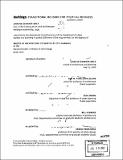Dockings : transitional housing for political refugees, Stockholm, Sweden
Author(s)
Mack, Jennifer Shannon, 1973-
DownloadFull printable version (23.26Mb)
Other Contributors
Massachusetts Institute of Technology. Dept. of Urban Studies and Planning.
Advisor
Ann M. Pendleton-Jullian and Bish Sanyal.
Terms of use
Metadata
Show full item recordAbstract
Inside its cocoon, a caterpillar changes slowly, transforming from one state of being to another over time, but always maintaining its fundamental essence and its origins. Similarly, a move from one place to another- whether by force or by choice, whether between nation-states or between cities-is a process of metamorphosis that happens individually for people with distinct and continuous identities. When they migrate, newcomers must learn the rules, both spoken and unspoken, that define and delineate the unfamiliar society; for refugees, any period of assimilation is also likely to include the need for recovery from involuntary losses and psychological traumas that may have been both the motivation for leaving and part of the journey. This is a process that takes emotion, energy, and, of course, time. This thesis understands this moment in the life of a migrant as one of extreme tension, and the cocoon's analogue- the physical space in which the transformation takes place- as the vessel in which it occurs. Through an examination of the government-distributed, transitional housing (genomgångsbostäder) for refugees living in Stockholm, Sweden, the thesis will clarify the psychological and social roles of this housing in the process of integration and illustrate the importance of its physical form to its successes and failures. The proposed strategy engages these questions and offers an alternative approach to their solution. The centerpoint of the proposal is the kitchen, where food, a vehicle for reproducing cultural memories, is prepared and initial social contacts are made. The project also seeks to activate its users- from the initial moment of moving in to the memories left behind when moving out-empowering them instead of creating dependencies. Finally, it attempts to establish ties between residents and outsiders by creating points of both concentrated and random interaction in semi-public and public spaces. As a transitional space, a rite of passage, and a place where regrounding can occur, the housing provides a temporary shelter and point of recovery from the vertigo of forced migration.
Description
Thesis (M.Arch.)--Massachusetts Institute of Technology, Dept. of Architecture; and, (M.C.P.)--Massachusetts Institute of Technology. Dept. of Urban Studies and Planning, 2002. Includes bibliographical references (p. 157-161).
Date issued
2002Department
Massachusetts Institute of Technology. Department of Architecture; Massachusetts Institute of Technology. Department of Urban Studies and PlanningPublisher
Massachusetts Institute of Technology
Keywords
Architecture., Urban Studies and Planning.